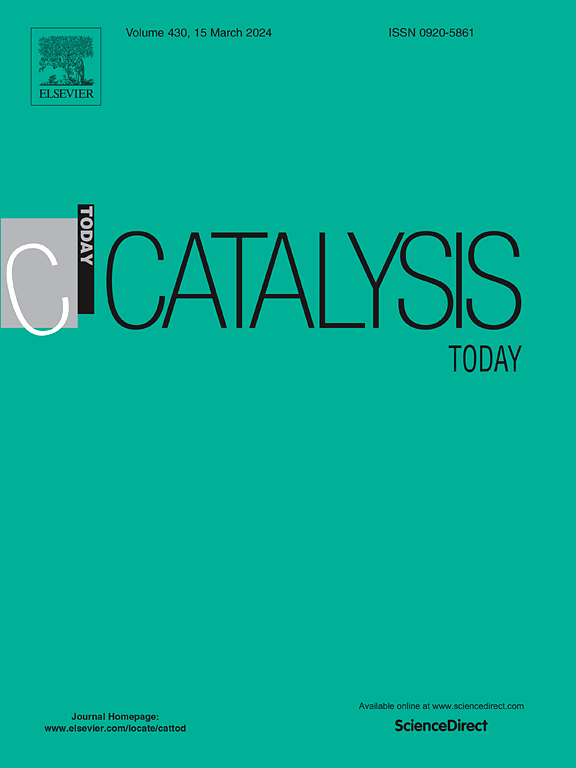One-pass conversion of syngas to BTX/para-xylene aromatics over tandem oxide-zeolite catalysts based on large crystal size HZSM-5
IF 5.2
2区 化学
Q1 CHEMISTRY, APPLIED
引用次数: 0
Abstract
The one-pass conversion of renewable syngas into aromatics, particularly to BTX (benzene, toluene, xylenes) and para-xylene (PX), represents a promising approach to produce high-value sustainable chemicals from non-fossil resources. In this work, a systematic study of the modification of HZSM-5 zeolite by surface silylation and incorporation of MgO was performed aiming at maximising the BTX and PX selectivity in the syngas-to-aromatics (STA) reaction using tandem Zn-ZrO2+HZSM-5 catalysts following the methanol route. A zeolite with unusually large crystal size was purposedly used to intensify the shape selectivity effect. This zeolite exhibited high BTX selectivity (53.0 % in aromatics) albeit poor stability with TOS. Generation of a proper amount of mesopores via controlled desilication improved the catalyst stability and the aromatics selectivity (from 59.2 % up to 73.2 %) at the cost of lowering the BTX selectivity. Effective passivation of the external Brønsted acid sites was reached by submitting the mesoporous zeolite to four silylation cycles with TEOS. The silylation treatment significantly raised the BTX selectivity to 52.1 % while maintaining high selectivity of total aromatics (67.9 %), but had only a moderate positive effect on PX selectivity. Incorporation of Mg species in the silylated zeolite produced the largest impact on PX selectivity, attaining an outstanding value of 76.8 % in xylenes (41.2 % in aromatics) upon loading 3 wt% Mg.
基于大晶粒HZSM-5的串联氧化物-沸石催化剂上合成气一次转化为BTX/对二甲苯芳烃
将可再生合成气一次转化为芳烃,特别是苯、甲苯、二甲苯和对二甲苯(PX),代表了一种从非化石资源中生产高价值可持续化学品的有前途的方法。在这项工作中,系统地研究了通过表面硅基化和MgO的掺入对HZSM-5沸石进行改性,目的是在甲醇路线下使用串联Zn-ZrO2+HZSM-5催化剂在合成气制芳烃(STA)反应中最大化BTX和PX的选择性。为了增强分子筛的形状选择性,特意选用了一种晶体尺寸异常大的沸石。该分子筛在芳烃中具有较高的BTX选择性(53.0 %),但在TOS中的稳定性较差。通过控制脱硅产生适量的介孔,提高了催化剂的稳定性和芳烃选择性(从59.2% %提高到73.2 %),但降低了BTX的选择性。通过将介孔沸石与TEOS进行四次硅基化循环,达到了外部Brønsted酸位的有效钝化。硅烷化处理显著提高了BTX的选择性,达到52.1 %,同时保持了对总芳烃的高选择性(67.9% %),但对PX的选择性只有适度的积极影响。在硅烷基化沸石中加入Mg对PX的选择性影响最大,当负载3 wt% Mg时,二甲苯的选择性为76.8% %,芳烃的选择性为41.2% %。
本文章由计算机程序翻译,如有差异,请以英文原文为准。
求助全文
约1分钟内获得全文
求助全文
来源期刊

Catalysis Today
化学-工程:化工
CiteScore
11.50
自引率
3.80%
发文量
573
审稿时长
2.9 months
期刊介绍:
Catalysis Today focuses on the rapid publication of original invited papers devoted to currently important topics in catalysis and related subjects. The journal only publishes special issues (Proposing a Catalysis Today Special Issue), each of which is supervised by Guest Editors who recruit individual papers and oversee the peer review process. Catalysis Today offers researchers in the field of catalysis in-depth overviews of topical issues.
Both fundamental and applied aspects of catalysis are covered. Subjects such as catalysis of immobilized organometallic and biocatalytic systems are welcome. Subjects related to catalysis such as experimental techniques, adsorption, process technology, synthesis, in situ characterization, computational, theoretical modeling, imaging and others are included if there is a clear relationship to catalysis.
 求助内容:
求助内容: 应助结果提醒方式:
应助结果提醒方式:


